- Soil Association
- Farmers & growers
- Low-input farming advice
- Companion cropping - intercropping

Companion cropping - intercropping
Download a printable PDF of this intercropping technical guide
What is intercropping?
Intercropping, also known as bi-cropping or companion cropping, is a technique of growing two or more crop species together in the same plot of land. Each species benefits the others by providing support, nutrition and assistance against stressors, such as shade and weed suppression, or by encouraging beneficial predators and pollinators.
Effectively by growing two crops in the same field you get some resilience against weather and potentially have more products to sell.
What the science says
Intercropping is a time-tested farming method strongly backed by science. It's a low-cost, practical way to boost yields, improve soil health and build resilience. It's especially useful for farmers looking to reduce fertiliser and pesticide use.
A way to assess productivity is by calculating the Land Equivalent Ratio (LER), which indicates whether cereal-legume combinations are more efficient than monocultures. Using this LER approach, the Agronomy DIVERSify project found intercropping optimised resource use, producing a 30% greater yield on farms across Europe (Brooker et al., 2024, Agron. Sustain. Dev.). Other studies suggest yield gains of 20%-40% (Li et al., 2020, Nature Plants).
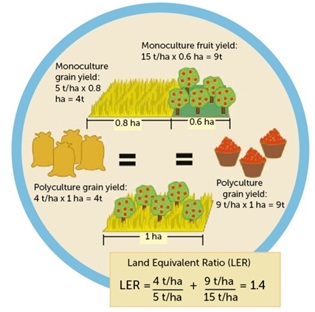
Land Equivalent Ratio (LER)
This productivity boost comes from resource sharing. Cereals and legumes use water, nutrients and light at different times and depths, so they don’t compete as much. Legumes also fix nitrogen from the air into the soil, helping the cereal crop and reducing fertiliser needs (Cong et al., 2015, Plant and Soil).
Intercropping improves soil structure and biology, with better organic matter, more microbial life and reduced erosion. Farmers often notice better tilth and more earthworms. It also helps reduce pests and diseases.
Mixed crops disrupt pest cycles and attract more beneficial insects. This means fewer chemical sprays are needed and costs are reduced (Khan et al., 2011, Field Crops Research).
Intercropping also spreads risk. If one crop under-performs, the other can compensate. This helps stabilise income and offers more marketing options (Raseduzzaman & Jensen, 2017, Field Crops Research).
There is on-going research on intercropping across Europe through the Leguminose project, with tools and farmer guidance focusing on making legume-based intercropping a real option for modern farming.
How does it fit the whole farm system?
Intercropping provides an opportunity to grow more crops within an arable rotation. You are increasing resilience by reducing the risk of monocrop failure caused by pest or climatic factors. Increased resource for pollinators and beneficials can decrease pest infestation and improve the pollination of pulses.
The diversity in the field makes it harder for pests and disease to spread quickly. Different crops are susceptible to different pests and diseases, so mixed crops provide each other with protection. There is also an indication that healthier soil – often the result of intercropping – makes the plant more resilient. While much of the evidence is anecdotal, many farmers say they deal with fewer pest and disease problems when they intercrop.
On a mixed farm, the combined product can be used as a feedstuff, often without additional supplementation, reducing production costs. The cereal can also be seen as a ‘nurse crop’ when growing ‘niche’ crops for high value marketplaces, such as human consumption. In organic rotations, an intercrop including pulses is a good way to extend the rotation by bringing in additional fertility late in the normal crop rotation, before returning to a grass/clover fertility building period. Although pulses are seen as a weedy crop, there is evidence that intercrops are actually less weedy.
Timescales (medium and short term)
Planting time needs to be selected to suit the mix and so should be planned to suit the most susceptible species, particularly when crops like peas are included.
Cereals will move through growth stages if they are planted later, but pulses planted too early will fail to germinate or develop.
Generally, harvest dates converge, although variety selection can be important, with some varieties being earlier or later than others. Harvesting slightly early and drying in store is a practical solution and intercrops can be swathed to level up ripening.
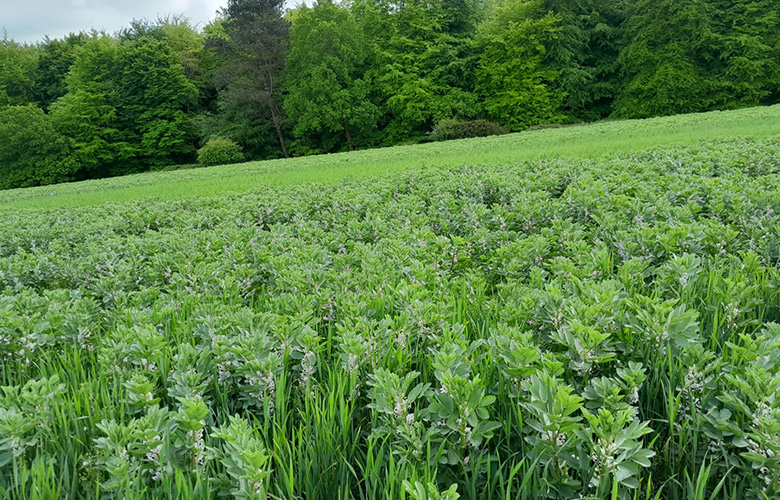
Intercrop of beans and wheat (pic: Jerry Alford)
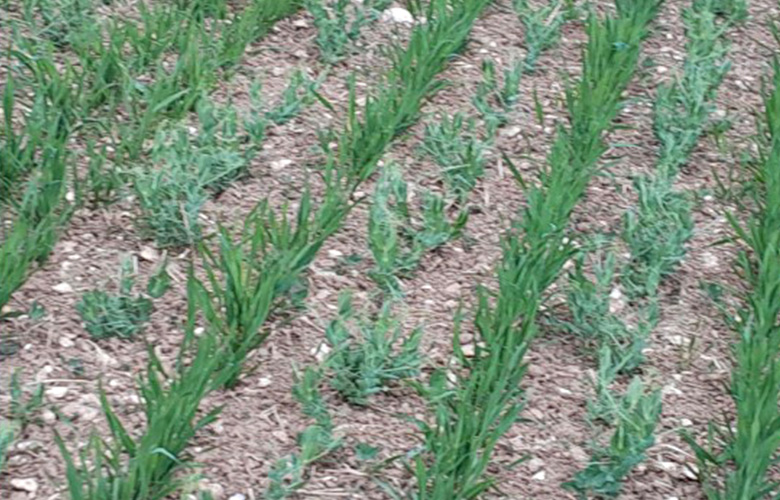
Peas and oats planted in intercrop strips (pic: Jerry Alford)
Diversity in cropping
Looking to increase diversity in cropping and widen the market opportunities, one farmer tried two new crop options in the same field. The farm traditionally growing winter cereals, decided to trial spring oats and spring beans, planting an area of each crop individually and a third area with a combination of the two to see if there would be any additional benefit.
A dry summer resulted in poor yields of both monocrops, producing 2.5t/ha each. but the combined plot yielded 3.7t/ha (combine monitor yields), a LER of 1.53.
Why should I be doing this?
Intercropping has been shown to increase total arable field production by up to 30% in a series of trials, through better use of space and sharing nutrients, calculated by using Land Equivalent Ratio (LER). For example, combining peas with barley can allow for easier harvesting because the barley straw holds up the peas.
Intercrops are also less weed prone because of increased plant densities and an improved ecosystem, thought to be associated with interplant interactions. Typically, intercrops are harvested together as a combined crop. This means you choose two species that ripen at the same time and run them through the combine together. The challenge is managing different types of crops, like small grains and larger beans, which need careful setup for the combine.
They can also benefit from improved yield stability with a diversification of crops responding differently to climate conditions, increasing the likelihood of at least one crop doing well. This spreads the risk to support better farm resilience. These resource-use efficiency increases will benefit arable and feed growing livestock systems.
How do I make sure intercropping will work for me?
The crops grown should be complimentary to allow them to be harvested together, although drilling dates can be different if equipment allows. Common mixes such as beans and wheat, peas and barley, and ‘boats’ (beans and oats) do generally reach harvest maturity together. When growing mixed crops, being aware of market outlet is essential. If the plan is human consumption markets, then the crops will need to be separated post-harvest. Crops with big differences between grain sizes, such as beans and wheat, are easy to separate using on farm cleaning equipment. Barley and peas are harder due to similar sizes, so using a colour separator or gravity table may be necessary. Compatibility is important, so selecting species that will grow well together and are planted and harvested around the same time. For example, peas harvest is easier when grown with oats because the oats give them something to climb on. Be prepared for differences in crops, and it’s especially important to pick varieties with similar harvest dates.
Generally, seed rates are around 60-80% per crop. Oats are competitive and often require lower rates - generally 40kg is enough for winter oats. Ratios can be varied depending on intended output, with higher pulse seed rates producing higher proportional pulse yields that will benefit cereal crop health. Harvest is straightforward with combine wind settings set for the lighter crop and concave settings for the biggest crop.
Drilling both crops together is common. Drilling depth is generally suited to the pulse, with cereals growing from relative depth. Bird predation can be an issue if pulses are too shallow, particularly for winter sown intercrops. Legumes can fix their own nitrogen, meaning they don’t need artificial fertilisers. The expectation when you’re growing legumes with cereals is that the legume will be feeding or supporting the cereal some extent. But there’s some work exploring whether applying low levels of fertiliser early in the season might still be beneficial. There are indications that wheat in wheat-bean intercrops may have higher protein content due to late-season nitrogen.
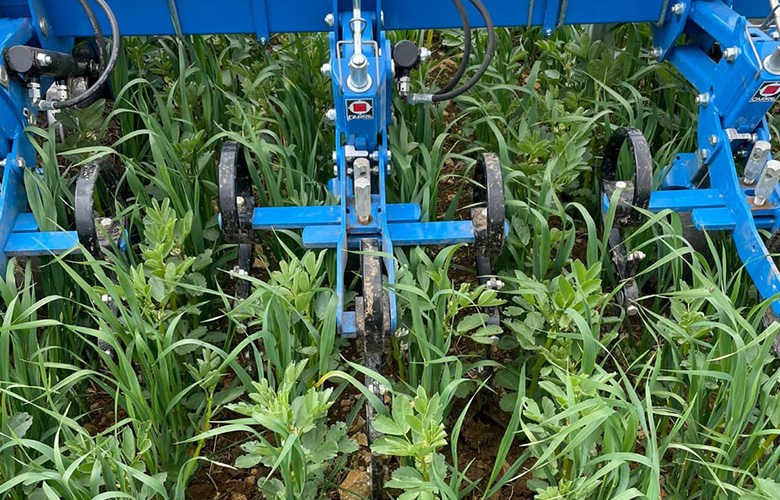
Mechanical weeding of intercropped beans and oats (pic: S. Blanch)
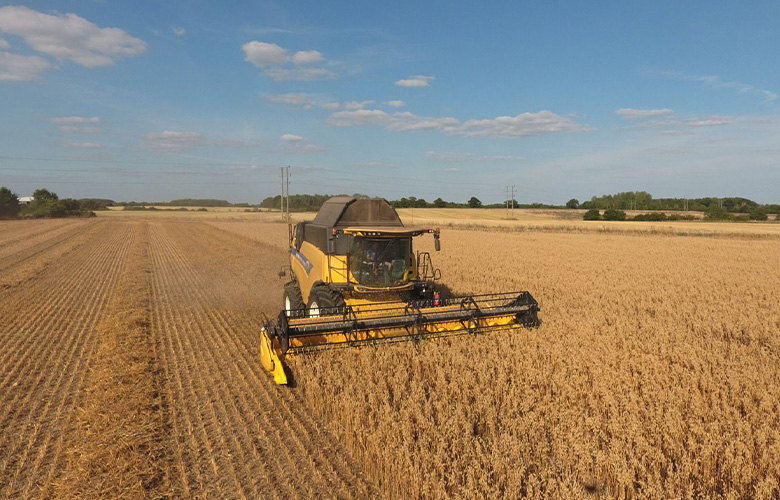
Combining an intercrop of beans and oats (pic: S Blanch)
Measuring and monitoring
Although total yield of crop harvested per hectare (ha) will generally be higher, individual crops may yield less than when grown as a monocrop. Pest and disease control in non-organic systems is difficult due to a lack of approved chemicals. However, experiences in organic systems shows intercropping contains less risk with mixes. These limit speed of disease spread and provide greater opportunity for beneficial insects.
Costs, savings and improvement
There will be increased costs incurred through additional seed used, and depending on equipment, additional passes with the drill. If the crop is intended for human consumption markets, there will also be a cost for separation. There will be savings of fertiliser and agrochemicals because of the reduced risk and need. The soil nitrogen residue will reduce costs in following crops. Improved soil structures commonly associated with pulses will also benefit following crops.
Crop separation is an additional operation and is dependent on the two crops being different sizes, although machines separating based on colour do already exist on the market. Existing on-farm cleaners can be used but may require a little adaptation to separate the two crops as well as dust, trash and weed seeds to reach market specification, particularly for human consumption markets.
The ability to separate does provide marketing opportunities. Livestock producers will be able to utilise the mixed product, but here is a growing market for intercrop products. Farmers can sell crops separately into a market or as combined product, which is appealing to feed mills. These mills can process combined products without needing to separate them, making it a cost-effective option. For example, a mix of high-protein wheat and beans can be directly integrated into feed rations.
Future impact
The soil nitrogen (N) residues will be dependent on the quantity of pulses in the mix but nitrogen residues of up to 250kg/N have been seen in bean/wheat intercrops. There is some indication of increased grain protein in intercropped cereals. The benefits of pulses, even at lower populations in intercrops, are seen in the crops that follow through nitrogen residues, nutrient release and soil health improvements.
One main challenge is getting intercrops that include pulses to fit into rotations, particularly with concerns about root disease. Coupled with guidance that pulses are used one year in five, this needs further consideration and more evidence to measure impact.
